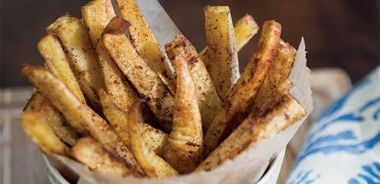Moroccan-Spiced Parsnip Fries with Creamy Lemon Dip

Parsnips are much like a cinnamon-infused, blonde carrot, marrying well with the heady aroma of Moroccan spices. The lemony dip acts as a welcome contrast to their perfumed richness.
Creamy Lemon Dip
7 oz (200 g) firm tofu, crumbled
1/4 cup (60 mL) water
Zest of 1 lemon
3 Tbsp (45 mL) lemon juice
1 Tbsp (15 mL) nutritional yeast
1/2 tsp (2 mL) sea salt
1/4 tsp (1 mL) garlic powder or 1/2 garlic clove, minced
Moroccan-Spiced Parsnip Fries
3 lb (1.5 kg) parsnips, peeled and cut into 2 1/2 x 1/2 in (6.5 x 1.25 cm) strips
3 Tbsp (45 mL) grapeseed oil
1 tsp (5 mL) ground cumin
1/2 tsp (2 mL) sea salt
1/2 tsp (2 mL) ground cinnamon
1/4 tsp (1 mL) chili flakes, or more to taste
1/4 tsp (1 mL) dried ground ginger
1/4 tsp (1 mL) ground pepper
To prepare Creamy Lemon Dip, add all ingredients to blender or food processor. Purée until smooth and creamy. Thin with additional water if desired, 1 Tbsp (15 mL) at a time, to achieve thinner dip. Transfer to serving bowl, cover, and refrigerate for at least 30 minutes, or up to 2 days.
To prepare Moroccan Spiced Parsnip Fries, preheat oven to 450 F (230 C). On large rimmed baking sheet, toss parsnips with remaining ingredients until evenly coated. Spread in a single layer. Roast for 10 minutes. Stir with flat spatula. Roast for additional 10 to 15 minutes, until tender and crisp, keeping an eye out for burning. Serve immediately with Creamy Lemon Dip.
Serves 6.
Each serving contains: 264 calories; 8 g protein; 9 g total fat (1 g sat. fat, 0 g trans fat); 45 g total carbohydrates (11 g sugars, 8 g fibre); 415 mg sodium
source: "Roots to Relish", alive #385, November 2014





